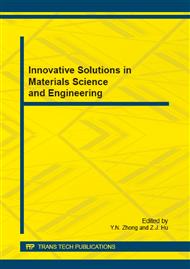p.62
p.67
p.72
p.76
p.80
p.85
p.90
p.95
p.102
Fabrication of Stable Superhydrophobic Surface with Low Adhesion on Aluminum Foil
Abstract:
Metal aluminum surface can be corroded easily in acid and alkaline environment. Inspired by the self-cleaning lotus leaf, the development of superhydrophobic metal surfaces to prevent metals from corroding is enjoying tremendous popularity amongst scientists and engineers. In this work, superhydrophobic surface was obtained on aluminum foils via a facile neutral sol solution immersion process and post-modification in ethanol solution of heptadecafluoro-1,1,2,2-tetradecyl trimethoxysilane (FAS-17) solution through a hydrothermal synthesis technique. Scanning electron microscopy (SEM), X-ray diffraction (XRD) and water contact angle measurement are used to investigate the morphologies, microstructures, chemical compositions and wettability of the produced films on aluminum substrates. The results indicated that the superhydrophobic surface, configured of a rough labyrinth structure with convexity and notch, has robust hydrophobility, which had a static water contact angle of 165.6 ± 2.8° and a water roll-off angle of <1°, exhibited long-term durability and stability in air. The present research work provides a new strategy for the simple preparation superhydrophobic films on aluminum foil for practical industrial applications.
Info:
Periodical:
Pages:
80-84
Citation:
Online since:
November 2014
Authors:
Price:
Сopyright:
© 2015 Trans Tech Publications Ltd. All Rights Reserved
Share:
Citation:


